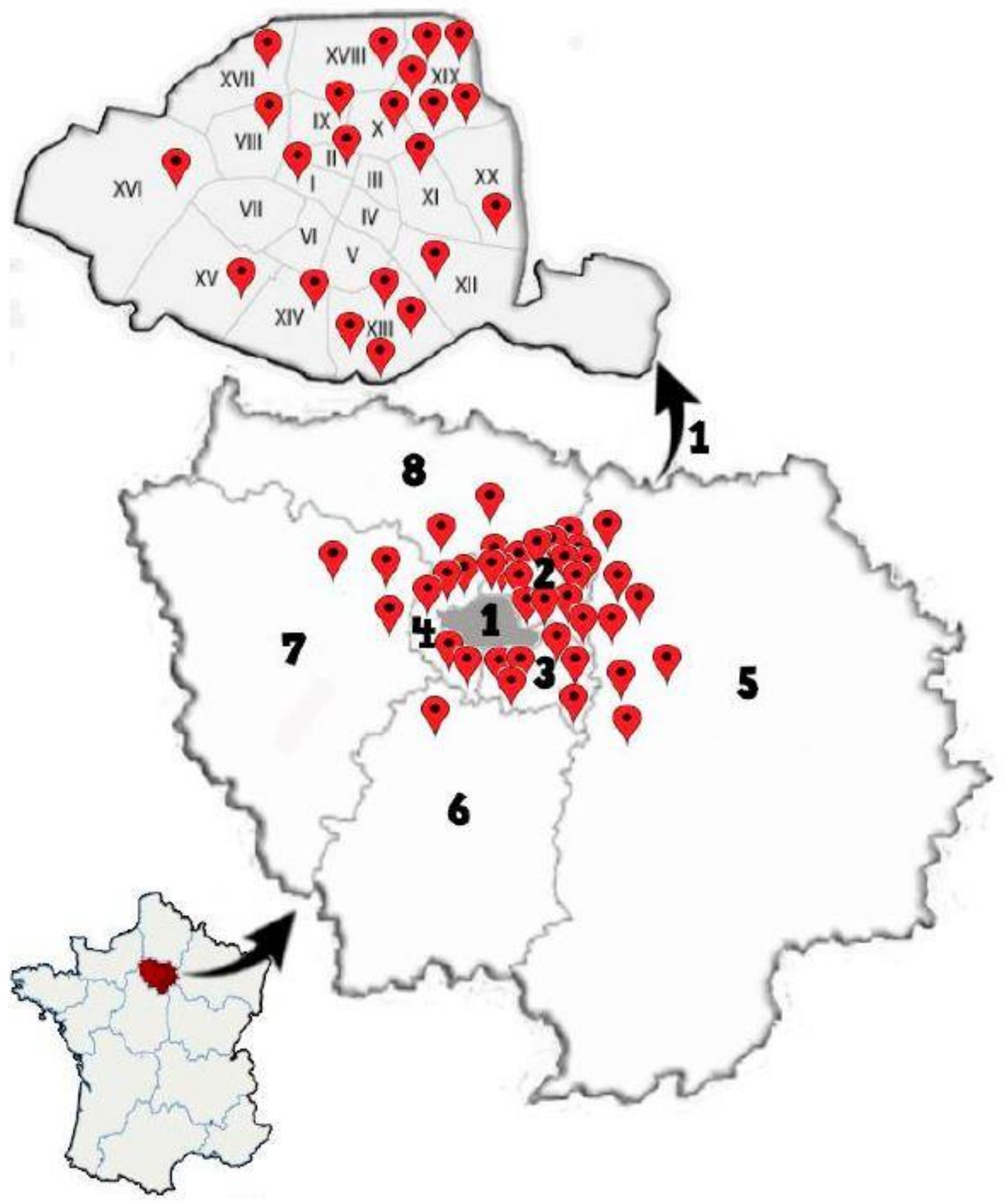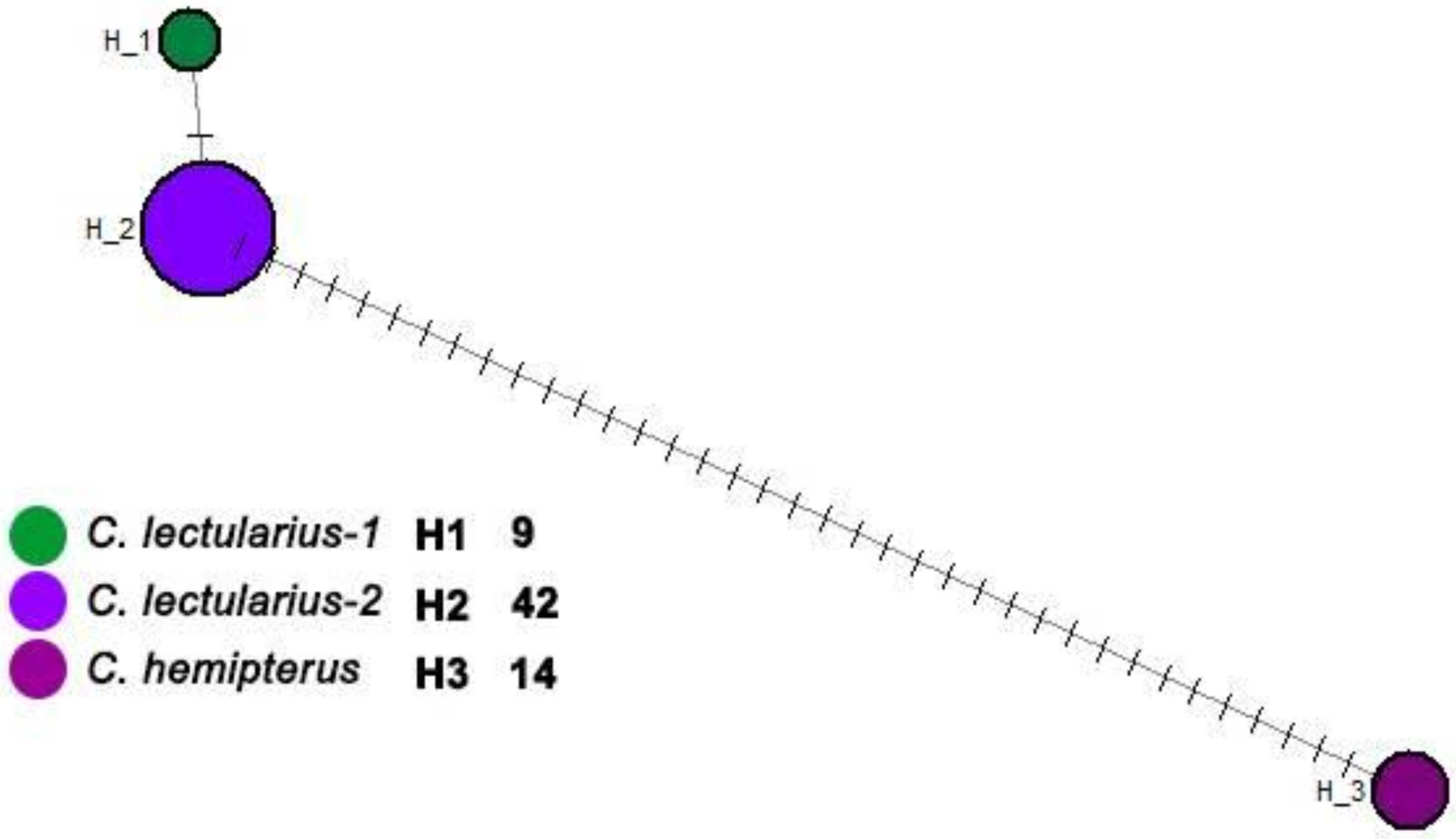Bed Bugs (Hemiptera: Cimicidae) Population Diversity and First Record of Cimex hemipterus in Paris
Abstract
:Simple Summary
Abstract
1. Introduction
2. Materials and Methods
2.1. Bed Bug Collection
2.2. DNA Extraction and PCR Amplification
2.3. Phylogenetic Reconstruction and Species Assignation
3. Results
4. Discussion
5. Conclusions
Supplementary Materials
Author Contributions
Funding
Institutional Review Board Statement
Informed Consent Statement
Data Availability Statement
Conflicts of Interest
References
- Akhoundi, M.; Sereno, D.; Durand, R.; Mirzaei, A.; Bruel, C.; Delaunay, P.; Marty, P.; Izri, A. Bed Bugs (Hemiptera, Cimicidae): Overview of Classification, Evolution and Dispersion. Int. J. Environ. Res. Public Health 2020, 17, 4576. [Google Scholar] [CrossRef]
- Harlan, H.J.; Faulde, M.K.; Baumann, G.J. Bedbugs. In Public Health Significance of Urban Pests; Bonnefoy, X., Kampen, H., Sweeney, K., Eds.; World Health Organization: Copenhagen, Denmark, 2008; pp. 131–151. [Google Scholar]
- Doggett, S.L.; Russell, R.C. The resurgence of bed bugs, Cimex spp. (hemiptera: Cimicidae) in Australia. In Proceedings of the Sixth International Conference on Urban Pests, Veszprém, Hungary, 12 January 2008. [Google Scholar]
- Romero, A.; Potter, D.; Haynes, K. Insecticide resistance in the bed bug: A factor in the pest’s sudden resurgence? J. Med. Entomol. 2007, 145, 175–178. [Google Scholar]
- Krause-Parello, C.A.; Sciscione, P. Bedbugs: An equal opportunist and cosmopolitan creature. J. Sch. Nurs. 2009, 25, 126–132. [Google Scholar] [CrossRef]
- Goddard, J.; de Shazo, R. Bed bugs (Cimex lectularius) and clinical consequences of their bites. JAMA 2009, 301, 1358–1366. [Google Scholar] [CrossRef]
- Akhoundi, M.; Sereno, D.; Marteau, A.; Bruel, C.; Izri, A. Who Bites Me? A Tentative Discriminative Key to Diagnose Hematophagous Ectoparasites Biting Using Clinical Manifestations. Diagnostics 2020, 10, 308. [Google Scholar] [CrossRef]
- Delaunay, P. Human Travel and Traveling Bedbugs. J. Travel Med. 2012, 19, 373–379. [Google Scholar] [CrossRef]
- Salazar, R.; Castillo-Neyra, R.; Tustin, A.W.; Borrini-Mayorí, K.; Náquira, C.; Levy, M.Z. Bed bugs (Cimex lectularius) as vectors of Trypanosoma cruzi. Am. J. Trop. Med. Hyg. 2015, 92, 331–335. [Google Scholar] [CrossRef]
- Leulmi, H.; Bitam, I.; Berenger, J.M.; Lepidi, H.; Rolain, J.M.; Almeras, L.; Raoult, D.; Parola, P. Competence of Cimex lectularius Bed Bugs for the Transmission of Bartonella quintana, the Agent of Trench Fever. PLoS Negl. Trop. Dis. 2015, 9, e0003871. [Google Scholar]
- Doggett, S.; Miller, D.M.; Lee, C.Y. Advances in the Biology and Management of Modern Bed Bugs; Ulrich, K.R., Karmer, M.H., Feldlaufer, M.F., Eds.; Wiley and Sons: Hoboken, NJ, USA, 2017. [Google Scholar]
- Seri Masran, S.N.A.; Majid, A.H. Genetic Diversity and Phylogenetic Relationships of Cytochrome C Oxidase Subunit I in Cimex hemipterus (Hemiptera: Cimicidae) Populations in Malaysia. J. Med. Entomol. 2017, 54, 974–979. [Google Scholar] [CrossRef]
- Balvín, O.; Munclinger, P.; Kratochvíl, L.; Vilímová, J. Mitochondrial DNA, and morphology show independent evolutionary histories of bedbug Cimex lectularius (Heteroptera: Cimicidae) on bats and humans. Parasitol. Res. 2012, 111, 457–469. [Google Scholar] [CrossRef] [PubMed]
- Doggett, S.L.; Geary, M.J.; Russell, R.C. The resurgence of bedbugs in Australia, with notes on their biology and control. Environ. Health 2003, 4, 30–38. [Google Scholar]
- Reinhardt, K.; Siva-Jothy, M.T. Biology of the bed bugs (Cimicidae). Annu. Rev. Entomol. 2007, 52, 351–374. [Google Scholar] [CrossRef] [Green Version]
- Akhoundi, M.; Kengne, P.; Cannet, A.; Brengues, C.; Berenger, J.M.; Izri, A.; Marty, P.; Simard, F.; Fontenille, D.; Delaunay, P. Spatial genetic structure and restricted gene flow in bed bugs (Cimex lectularius) populations in France. Infect. Genet. Evol. 2015, 34, 236–243. [Google Scholar] [CrossRef] [PubMed]
- CNEV. La Punaise de Lit en France: État des Lieux et Recommandations; CNEV: Montpellier, France, 2015. [Google Scholar]
- Usinger, R. Monograph of Cimicidae (Hemiptera-Heteroptera): The Thomas Say Foundation; Entomological Society of America: Lanham, MD, USA, 1966. [Google Scholar]
- Walpole, D. External morphology of the legs of two species of bed bugs (Hemiptera: Cimicidae). J. Entomol. Soc. S. Afr. 1987, 50, 193–201. [Google Scholar]
- Walsh, P.S.; Metzger, D.A.; Higuchi, R. Chelex 100 as a medium for simple extraction of DNA for PCR-based typing from forensic material. Biotechniques 1991, 10, 506–513. [Google Scholar] [CrossRef] [PubMed] [Green Version]
- Hall, T.A. BioEdit: A user-friendly biological sequence alignment editor and analysis program for Windows 95/98/NT. In Nucleic Acids Symposium Series; Information Retrieval Ltd.: London, UK, 1999. [Google Scholar]
- Kumar, S.; Tamura, K.; Nei, M. MEGA3: Integrated software for Molecular Evolutionary Genetics Analysis and sequence alignment. Brief Bioinform. 2004, 5, 150–163. [Google Scholar] [CrossRef] [PubMed] [Green Version]
- Bandelt, H.J.; Forster, P.; Rohl, A. Median-joining networks for inferring intraspecific phylogenies. Mol. Biol. Evol. 1999, 16, 37–48. [Google Scholar] [CrossRef] [PubMed]
- Akhoundi, M.; Chebbah, D.; Sereno, D.; Marteau, A.; Jan, J.; Bruel, C.; Elissa, N.; Izri, A. Widespread Mutations in Voltage-Gated Sodium Channel Gene of Cimex lectularius (Hemiptera: Cimicidae) Populations in Paris. Int. J. Environ. Res. Public Health 2021, 18, 407. [Google Scholar] [CrossRef]
- Global Tourism 2019. Available online: https://www.e-unwto.org/doi/pdf/10.18111/9789284421152 (accessed on 24 June 2019).
- Candy, K.; Akhoundi, M.; Bruel, C.; Izri, A. Ineffectiveness of Insecticide Bendiocarb Against a Cimex lectularius (Hemiptera: Cimicidae) Population in Paris, France. J. Med. Entomol. 2018, 55, 1648–1650. [Google Scholar] [CrossRef]
- Berenger, J.M.; Pluot-Sigwalt, D. Présence en France de la Punaise de lit tropicale, Cimex hemipterus (Fabricius, 1803) (Hemiptera, Heteroptera, Cimicidae). Bull. Soc. Entomol. France 2017, 122, 423–427. [Google Scholar] [CrossRef]
- Masini, P.; Zampetti, S.; Miñón Llera, G.; Biancolini, F.; Moretta, I.; Romani, R.; Tramontana, M.; Hansel, K.; Stingeni, L. Infestation by the tropical bedbug Cimex hemipterus (Hemiptera: Cimicidae): First report in Italy. J. Eur. Acad. Dermatol. Venereol. 2020, 34, e28–e30. [Google Scholar] [CrossRef] [PubMed] [Green Version]
- Zorrilla-Vaca, A.; Silva-Medina, M.M.; Escandón-Vargas, K. Bed bugs, Cimex spp.: Their current world resurgence and healthcare impact. Asian Pac. J. Trop. Dis. 2015, 5, 342–352. [Google Scholar] [CrossRef]
- Robinson, W. Bedbugs knock roaches off the list. Pest Control 2004, 1, 51–53. [Google Scholar]
- Eddy, C.; Jones, S. Bed bugs, public health and social justice: Part 1, a call to action. J. Environ. Health 2011, 2, 8–14. [Google Scholar]
- Kress, W.J.; Erickson, D.L. DNA barcodes: Genes, genomics, and bioinformatics. Proc. Natl. Acad. Sci. USA 2008, 105, 2761–2762. [Google Scholar] [CrossRef] [PubMed] [Green Version]
- Ondrejicka, D.A.; Locke, S.A.; Morey, K.; Borisenko, A.V.; Hanner, R.H. Status and prospects of DNA barcoding in medically important parasites and vectors. Trends. Parasitol. 2014, 30, 582–591. [Google Scholar] [CrossRef]



| Cimex Species | COI Haplotypes | 1 Regional Distribution | |
|---|---|---|---|
| Haplotype | Frequency | ||
| C. lectularius | H01 | 9 | Paris (5), Finland, Czechia, Hungary (2) |
| H02 | 42 | Paris (39), USA, UK, Czechia | |
| C. pipistrelli | H03, H04 | 5 | Germany, Netherlands (3), Romania |
| C. japonicus | H05 | 1 | |
| C. emarginatus | H06 | 1 | |
| C. hemipterus | H07 | 14 | Paris (4), China (2), Thailand (2), Malaysia (2), Iran, Bangladesh, Senegal, Kenya |
| C. pilosellus | H08 | 2 | |
| C. brevis | H09 | 1 | |
| C. latipennis | H10, H11 | 2 | |
| C. antennatus | H12 | 1 | |
| C. adjunctus | H13 | 4 | |
| Areas of Paris | Haplotypes | Frequency |
|---|---|---|
| Paris arrondissements | H1, H2 | 2, 18 |
| Meudon | H2 | 2 |
| Neuily sur Marne | H2 | 1 |
| Asnieres | H2 | 1 |
| La Courneuve | H2 | 1 |
| Pantin | H1, H2 | 1, 1 |
| Aubervilliers | H2 | 4 |
| Stains | H2 | 1 |
| Marly le Roi | H2 | 1 |
| Drancy | H2 | 2 |
| Sarcelles | H2 | 1 |
| Noget sur Marne | H2 | 1 |
| Nanterre | H2 | 1 |
| Chilly Mazarin | H2 | 1 |
| Creteil | H2 | 1 |
| Montreuil | H1, H2 | 1, 1 |
| Bobigny | H1 | 1 |
Publisher’s Note: MDPI stays neutral with regard to jurisdictional claims in published maps and institutional affiliations. |
© 2021 by the authors. Licensee MDPI, Basel, Switzerland. This article is an open access article distributed under the terms and conditions of the Creative Commons Attribution (CC BY) license (https://creativecommons.org/licenses/by/4.0/).
Share and Cite
Chebbah, D.; Elissa, N.; Sereno, D.; Hamarsheh, O.; Marteau, A.; Jan, J.; Izri, A.; Akhoundi, M. Bed Bugs (Hemiptera: Cimicidae) Population Diversity and First Record of Cimex hemipterus in Paris. Insects 2021, 12, 578. https://doi.org/10.3390/insects12070578
Chebbah D, Elissa N, Sereno D, Hamarsheh O, Marteau A, Jan J, Izri A, Akhoundi M. Bed Bugs (Hemiptera: Cimicidae) Population Diversity and First Record of Cimex hemipterus in Paris. Insects. 2021; 12(7):578. https://doi.org/10.3390/insects12070578
Chicago/Turabian StyleChebbah, Dahlia, Nohal Elissa, Denis Sereno, Omar Hamarsheh, Anthony Marteau, Julie Jan, Arezki Izri, and Mohammad Akhoundi. 2021. "Bed Bugs (Hemiptera: Cimicidae) Population Diversity and First Record of Cimex hemipterus in Paris" Insects 12, no. 7: 578. https://doi.org/10.3390/insects12070578
APA StyleChebbah, D., Elissa, N., Sereno, D., Hamarsheh, O., Marteau, A., Jan, J., Izri, A., & Akhoundi, M. (2021). Bed Bugs (Hemiptera: Cimicidae) Population Diversity and First Record of Cimex hemipterus in Paris. Insects, 12(7), 578. https://doi.org/10.3390/insects12070578






